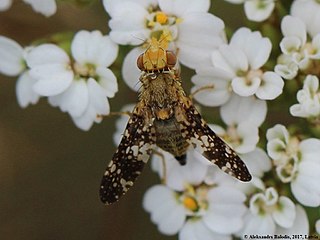Pegoplata, sometimes known as Nupedia, is a genus of flies within the family Anthomyiidae.

The Lonchopteridae are a family of small (2–5 mm), slender, yellow to brownish-black Diptera, occurring all over the world. Their common name refers to their pointed wings, which have a distinct venation. Many are parthenogenic; males are very rare, however, at least in North American species, and have a somewhat different venation than do the females.

The Lauxanioidea are a superfamily of flies that includes the two large families, the Lauxaniidae and Chamaemyiidae, and the small family Celyphidae. Generally, they are small to medium, densely populated, coloured flies. The Chamaemyiidae live as parasites on insects. The family Celyphidae look like beetles.

The Celyphidae, commonly known as beetle flies or beetle-backed flies, are a family of flies. About 115 species in about 9 genera are known chiefly from the Oriental and Afrotropic biogeographic regions with one lineage in the New World.

Xylota is a Holarctic genus of hoverflies similar in structure to the related genera Chalcosyrphus and Brachypalpoides. As the larvae are saprophytic they're usually found in rotting wood. The adult flies are generally associated with woodland and woodland edges and can often be seen running over the upper sides of leaves. Unlike other syrphids the adults of many species rarely visit flowers preferring instead to gather pollen from leaf surfaces. There are over 100 described species of which 12 can be found in Europe. Seven species have been recorded in Britain. Identification of species has been difficult and identifiction by photographs is risky.
Hamaxia is a genus of flies in the family Tachinidae.
Isosturmia is a genus of flies in the family Tachinidae.
Drino is a genus of flies in the family Tachinidae.
Zygobothria is a subgenus of flies in the family Tachinidae.

Linnaemya is a genus of flies in the family Tachinidae.

Oxyna is a genus of fruit flies in the family Tephritidae. There are at least 20 described species in Oxyna.
Mikia is a genus of flies in the family Tachinidae.
Celyphus is a genus of beetle flies. It is known from the Oriental and Afrotropical realms. Up to 1859, all species of beetle flies were placed in this genus.

Teleopsis is a genus of stalk-eyed flies in the family Diopsidae. All species in the genus are found in Asia. About 20 species are described and several others as yet are to be described.
Eosiopsis is a genus of stalk-eyed flies in the family Diopsidae.
Cyrtodiopsis is a genus of stalk-eyed flies in the family Diopsidae.
Eurydiopsis is a genus of stalk-eyed flies in the family Diopsidae.

Zhangsolvidae is an extinct family of brachyceran flies known from the Cretaceous period. Members of the family possess a long proboscis, varying in length between 1.3 and 7 mm depending on the species, and were probably nectarivores. A specimen has been found with preserved Bennettitales pollen, suggesting that they acted as pollinators for extinct gymnosperms. They are considered to be members of the Stratiomyomorpha.
Chen Xingcan (陳星燦) is a Chinese archaeologist specializing in the archaeology of China.







